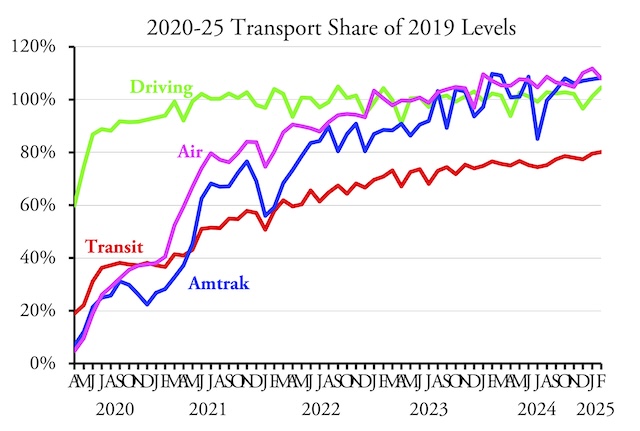Americans drove 4.6 percent more miles in February 2025 than in the same month of 2019, according to data released yesterday by the Federal Highway Administration. Both urban and rural driving surpassed 2019 levels, as well as driving on all major types of roads: interstates, other arterials, and other roads. This is the first time since the pandemic that driving on all types of roads exceeded 2019 levels.
The February release presented some surprises. While February driving in Massachusetts was still less than 90 percent of pre-pandemic miles, Californians drove 5.5 percent more, Hawaiians 8.0 percent more, and Oregonians 7.0 percent more miles than in 2019. The only western states where driving fell short of 2019 miles were New Mexico, Washington, and Wyoming.
Even more surprising, urban driving in all western states, except those three, exceeded 2019 levels, with California being 6.2 percent, Hawaii 9.3 percent, and Oregon 3.9 percent greater than 2019. Other than Massachusetts, the only states where urban driving was less than 90 percent of 2019 numbers were North Carolina, Kansas, and Michigan.
According to Census Bureau estimates, California lost population since 2020, so I can see why driving there was slow to catch up to 2019 levels. But North Carolina’s population has grown by around 6 percent, so the driving shortfall there seems a puzzle. However, while urban driving in North Carolina fell by 17 percent, rural driving grew by 46 percent, so perhaps North Carolinians responded to the pandemic by moving from urban to rural areas.
Other states whose population has declined since the beginning of the pandemic include Hawaii, Illinois, Louisiana, Mississippi, and West Virginia. It is likely that interstate migrations and urban-to-rural migrations account for a large part of the changes in driving in most states. Hawaii is an exception as tourism accounts for a lot of driving and the latest numbers suggest that the tourist industry there has fully recovered.
One caveat is that Federal Highway Administration mileage numbers are only estimates and not actual passenger counts such as the numbers reported by Amtrak and the airlines. The estimates for interstates and other arterials are most reliable while estimates for local roads are much more questionable. However, any errors in one year are likely to be replicated in other years so even for local roads the changes in driving from one year to the next are still fairly reliable.








